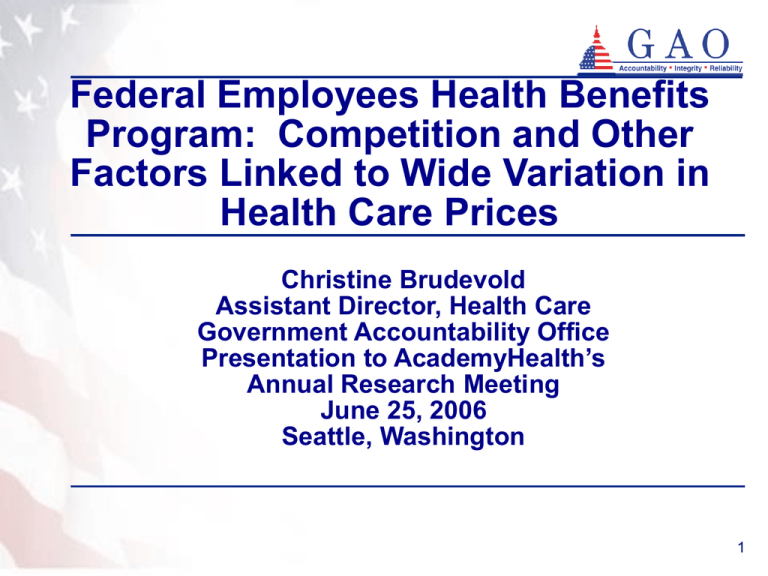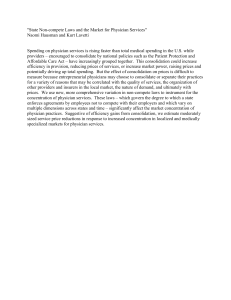Federal Employees Health Benefits Program: Competition and Other Health Care Prices
advertisement

Federal Employees Health Benefits Program: Competition and Other Factors Linked to Wide Variation in Health Care Prices Christine Brudevold Assistant Director, Health Care Government Accountability Office Presentation to AcademyHealth’s Annual Research Meeting June 25, 2006 Seattle, Washington 1 Background • Health care spending varies geographically, but underlying causes have not been fully explored, especially in the private sector • Spending = Price X Utilization • Most of the geographic variations research has focused on the utilization of services, not price 2 Study Objectives 1. The extent to which hospital and physician prices varied geographically in FEHBP PPOs 2. Which factors were associated with geographic variation in hospital and physician prices in FEHBP PPOs 3. The extent to which hospital and physician price variation contributed to geographic variation in spending in FEHBP PPOs 3 Study Population and Eligibility Criteria • Study Population: FEHBP • largest private health insurance program • contracts with private insurers • covered nearly 8 million enrollees (2004) • spent more than $21 billion (2004) Study eligibility criteria • FEHBP enrollees in selected national PPOs in 2001 • Individuals under the age of 65 • Primary insurer had to be one of the study PPOs • Excluded pharmaceutical, mental health and chemical dependency services 4 Methodology for Objective 1: Hospital and Physician Price Variation • Grouped claims by metropolitan areas • Computed average adjusted price for • a hospital stay (232 metropolitan areas) • a physician service (319 metropolitan areas) • Removed effect of geographic differences in costs of doing business and the mix of services • Price included insurer payments and enrollee payment obligations (deductibles and coinsurance) 5 Methodology for Objective 2: Factors Associated with Price Variation We examined factors that might be associated with price variation and developed quantitative measures: • Market Competition – percent of beds in the two largest hospitals or hospital networks • HMO Price Bargaining Leverage – percent of primary care physician compensation from HMOs that was capitated • Cost-shifting – Proportion of population without insurance, enrolled in Medicare or Medicaid, and average Medicaid payments to physicians for common procedures 6 Methodology for Objective 3: Decomposing Spending into Price and Utilization • Computed average adjusted utilization per enrollee and spending per enrollee for • hospital stays • physician services • Adjusted utilization for age and sex • Adjusted spending for costs, age, and sex • Compared prices and utilization in high and low spending areas 7 Prices Varied Widely Across Metropolitan Areas 8 Provider Competition and HMO Bargaining Leverage Associated with Price Variation 9 Cost-shifting Did Not Explain Higher Prices Results: Observed Expected relationship between factors relationship between factors and price if cost-shifting occurred and price Cost-shifting factor Percent Uninsured Average Medicaid Payment Percent on Medicare Percent on Medicaid Price Physician price Hospital price n.s. n.s. n.s. n.s. n.s. n.s. Source: GAO analysis of FEHBP and other data. n.s. = not significant 10 Price Contributed to About One Third of Variation in Spending Hospital spending Average hospital price quartile index Average hospital utilization index Highest spending quartile 1.12 1.24 Lowest spending quartile 0.89 0.80 Percent difference 25.8 55.0 Source: GAO analysis of FEHBP data. 11 Summary • Prices varied widely across metropolitan areas • Less provider competition was associated with higher prices • Less HMO price bargaining leverage was associated with higher prices • Cost-shifting did not explain higher prices • Price contributed to about 1/3 of variation in spending 12 Full report available at GAO website www.gao.gov/cgi-bin/getrpt?GAO-05-856 Title: Federal Employees Health Benefits Program: Competition and Other Factors Linked to Wide Variation in Health Care Prices Report number: GAO-05-856 13




